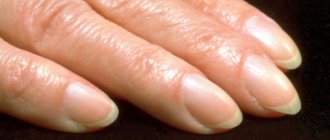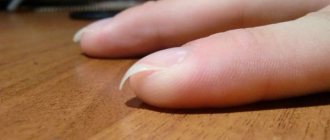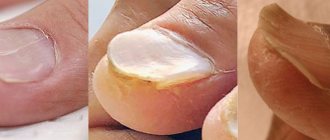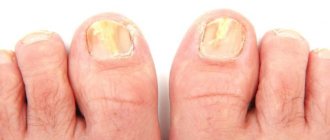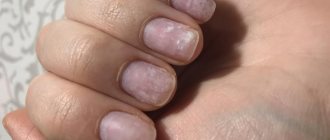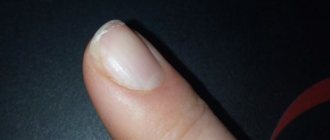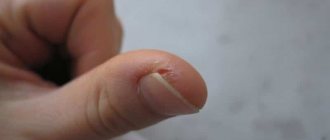Why do the nails on my big toes turn black?
External staining of the nail plate may be due to an internal disease, but the influence of external provoking factors is also possible. It is necessary to immediately consult a doctor to reliably determine what causes such a cosmetic defect. If the disease is infectious in nature, it is quite possible for the adjacent once healthy nail plate to darken. The appearance of unpleasant symptoms is appropriate if:
- a person wears uncomfortable shoes;
- an injury has occurred that is accompanied by hemorrhages of blood vessels;
- the person pre-treated the nail plates with potassium permanganate;
- wears shoes made of low-quality synthetic materials;
- This happens when the surface of the nail structure is damaged.
The toenail has turned black, but does not hurt
If healthy tissues turn black and there are no painful sensations, this does not mean that there is no pathological process. It is possible that it is at an early stage; an urgent response to alarming symptoms is required. Blackening of the big toe nail will not hurt when:
- fungal infections;
- wearing shoes made of dyeable materials;
- diabetes mellitus as one of the symptoms;
- frostbite;
- carelessly cut cuticle;
- external coloring;
- using dark varnishes;
- contact with potassium permanganate.
Accompanied by pain
If the nail on the thumb turns black and begins to hurt, this unpleasant condition can be caused by diseases of the internal organs, infectious processes, or impaired pressure of the blood vessels of the characteristic zone. To successfully treat darkening, the first step is to identify and eliminate the provoking factor. So, the affected finger turns black and hurts when:
- benign tumors;
- foot diseases;
- injuries and damage to the nail plate;
- abnormalities in the growth of the nail plate;
- malignant neoplasms;
- carelessly performed pedicure for men and women.
More often, nails turn black or blue after severe trauma, which may be accompanied by abnormal changes in the structure of the plate itself. In such patients, the pathological process will spread to the skin; in addition to the unpleasant color, an abscess (subcutaneous accumulation of pus) cannot be ruled out. After severe bruises, in addition to darkening of the nail plate and the appearance of a hematoma, the nail must be removed and wait for a healthy structure to grow back.
Brown nail
If the nail on your big toe has not turned black, but has only acquired a brown tint, do not panic too much. The nail plates acquire such an unpleasant shade when they come into contact with potassium permanganate or tight shoes. Having identified such causes of blackening, it is simply necessary to eliminate the provoking factor from the patient’s life. There is no need to treat spots or spots with conservative methods.
Serious illnesses
If such unpleasant spots form on the big toe, one should not exclude the presence of more dangerous causes of pathology. For example, this is an alarming sign of the appearance of a tumor of malignant origin, which unexpectedly appears with well-groomed nails. Doctors do not exclude other, no less dangerous diseases of the body at any age:
- diabetes;
- diseases of the cardiovascular system;
- extensive kidney damage;
- vascular pathologies;
- brain diseases;
- extensive pathologists of the central nervous system;
- benign tumor.
What does the color change mean?
Changes in the color of the nail plate are an important concomitant symptom of nail diseases and disorders of the internal organs. Let's look at what diseases can be identified by the color of the nails.
Yellow nails
Yellowing of the nail plate is caused by internal and external factors. Based on this symptom, one can suspect pathologies in the lungs, endocrine, lymphatic systems, difficulty in blood circulation in the feet, hands, problems with the liver, gall bladder, and psoriasis.
One of the most common causes of yellow coloring is fungal infection (onychomycosis). If treatment is not started in time, the infection will spread. The nail plate will begin to thicken, crumble, and peel off from the nail bed. Most often this nail disease occurs on the feet.
What other reasons lead to yellowing nails?
- smoking;
- age-related changes in nails;
- conditions after infectious diseases;
- taking certain medications;
- the use of cheap decorative varnishes;
- contact with aggressive detergents.
Depending on the cause, the intensity of the yellow color varies from weak and barely noticeable to rich, dark yellow or even brown.
White spots
White spots are a common nail disease called leukonychia. How does it manifest itself?
Due to the inclusion of air bubbles in the space between the nail plate and the bed, single or multiple white spots or stripes appear. Normally, the nail fits tightly to the bed and is pink in color. Only at the top, in the area of the free edge, do we see the nail white. The cause of leukonychia disease is damage to the nail matrix or plate under the influence of mechanical (trauma, shock) or other factors.
Leukonychia occurs after taking certain medications, with a deficiency or, conversely, an excess of iron, calcium or zinc, due to low hemoglobin levels. Occurs after nail extensions or sloppy manicure.
What this nail disease looks like on the hands is shown in the photo.
Uneven color
In some cases, the color of the nail is uneven. For example, the bottom half of the plate is white and the top half is pink. This symptom is called “half and half” and indicates the development of kidney failure. It causes swelling of the nail bed. Occurs in HIV-positive patients who have undergone chemotherapy.
Heterogeneous coloration in the form of whitening of 80% of the lower part of the nail plate and a small red rim on top is called Terry's symptom. This is typical for liver cirrhosis, heart failure, physiological aging, and severe diabetes.
What does this description of nail disease look like, look at the photo.
Another option for non-uniform coloring of the nail plate is Mührke lines. These are two parallel transverse white stripes, shaped like the arc of the lunula, separated by a normal pink color. Mührke's lines are associated with a decrease in the level of albumin protein in the blood in chronic kidney pathologies. When the protein level returns to normal, they disappear. And then they appear again when its concentration decreases.
Green nails
Coloring of the nail plates in green shades from yellow-green to greenish-blue or greenish-brown can be caused by:
- bruises due to injuries, bruises, pinched nails;
- fungal infection;
- bacterial infection (pseudomonas aeruginosa, psvedonia).
If your nails are green, you should consult a doctor as soon as possible. If there were no injuries, then the cause of such changes is infectious. Pathogens can be found between the natural nail plate and the nail bed or between the false nail and the natural nail.
Blue coloring
Blueness of the nails indicates poor blood circulation in the fingers or toes, lack of oxygen, and low hemoglobin levels. This is typical for anemia, chronic obstructive pulmonary pathology, asthma, infectious lung disease (pneumonia), severe disorders in the cardiovascular system, and heart disease.
Dark spots
Dark spots on the nail plate most often occur due to bruises and bleeding in the nail bed due to injuries. In women, longitudinal dark brown stripes on the nails sometimes appear against the background of hormonal disorders, after surgery on the pelvic organs, or during pregnancy.
Black spots under the nails cause liver disease or endocarditis (inflammation of the lining of the heart).
Dark pigmentation of the nails can be a side effect of certain medications (Zidovudine, Cyclophosphamide, Hydroxyurea, Doxorubicin).
A dangerous cause of spots in the form of a longitudinal dark stripe is subungual melanoma or malignant skin cancer.
Causes of white spots on nails
It is impossible to clearly name the reason for the appearance of white spots on nails. There can be many reasons, and none of the reasons is considered completely scientifically proven. All doctors are unanimous on one thing: leukinychia is not contagious, not dangerous, and often goes away on its own, without apparent cause or treatment. Although, if there are reasons that give rise to this phenomenon, then there are reasons due to which the condition of the nail plate returns to normal.
The main reason for “blooming” nails is a deficiency of minerals and vitamins in the body. This theory is supported by the fact that leukinychia most often occurs in the spring or at the end of winter, when the body experiences vitamin deficiency. Usually we are talking about a lack of B vitamins, vitamin D, calcium and iron.
“Blooming” nails very often appear in young girls who, at the end of winter and beginning of spring, begin to “get in shape”, go on diets, and limit themselves in nutrition. This leads not only to the development of vitamin deficiency, but, as a consequence, to the manifestation of vitamin deficiency on the nails. Usually, by the beginning of summer, nails stop “blooming” - the plate with already formed spots and dots grows back, but new elements do not appear.
Lesions of internal organs
Another reason for “blooming” nails is pathological changes in internal organs. It is believed that nails are a reflection of the internal state of the body, and from them one can “read” all diseases that have not yet manifested themselves in the form of pronounced symptoms, but are already visible on the foot plates.
Proponents of this theory of the occurrence of leukinychia insist that flowering nails are a consequence of problems with the thyroid gland or liver. However, official medicine is less categorical in this regard: today there are about thirty diseases that in one way or another affect the nails. Therefore, diagnosing the body by white spots on the nail plate is not a promising activity.
Nail plate injury
Very often, the appearance of a white stripe or spot on the nail plate is preceded by injury. At the site of injury, a keratinization of the plate is formed, which looks like a white spot. In this case, we are talking about a single case or a couple of spots. True leukinychia is characterized by an abundance of spots scattered throughout the nails in a chaotic manner.
Sometimes true leukinychia occurs as a result of wearing rough gloves or mittens. Wearing gloves that are too tight leads to poor circulation in the fingers and, accordingly, in the nails. This is reflected in the appearance of the nails - they become covered with white spots and stripes.
Also, frequent wearing of thick rubber gloves or rough work mittens leads to permanent injury to the nails. This is the reason for the appearance of leukinychia on the hands of people who are engaged in heavy physical labor using personal protective equipment.
You don't have to be a victim of poisoning to be poisoned. Low-quality cosmetics, cheap or expired nail polishes lead to poisoning, first of all, of the nail plate. The most harmful effects on nails, and the entire body, are caused by products containing chlorine and phosphates. Conscientious manufacturers do not use chlorine, and if it is added, they are required to report it. However, information about the presence of phosphates should also be on the product label.
However, not all manufacturers are honest with consumers, and varnish containing phosphates ends up in cosmetics. Sometimes it is enough to throw a bottle of expired varnish into the trash can for a “miraculous” cure to occur.
What is it and why did the spots appear?
The reasons why dark spots may appear on the nail plates of the feet and hands - on the thumbs and fingers - do not depend on age, gender or social status.
Most often, the appearance of such a defect on the legs and arms may mean that a disease is present.
The list of diseases is relative and does not always suit the same patient. It is necessary to conduct a complete examination of the body to make an accurate diagnosis.
Diseases
- Endocarditis and other diseases of the cardiovascular system.
- The spot looks like a hematoma, but there were no trauma factors.
- Liver problems: cirrhosis, hepatitis and others.
- Melanoma. The spot increases in size and gradually begins to appear on the skin. This indicates the possibility of growth of a malignant tumor - melanoma.
- Poor nutrition and vitamin deficiency.
Spots appear on the nails of both hands and feet. They signal that the body lacks folic acid, protein, vitamin B12, and other vitamins. With this pathology, in addition to dark spots, brittleness and fragility of the nails are observed. - Diabetes. The appearance of spots is associated with metabolic disorders and trophic changes in tissues.
- Kidney failure.
- Hemangioma. A benign tumor forms under the nail plate and is dark brown in color. It does not cause pain and sometimes goes away on its own.
- Hyperpigmentation. It is temporary and occurs in people sensitive to chemicals, ultraviolet rays and low-quality cosmetics.
- Poor nail care, poor quality manicure and pedicure. If there is any change in the color or integrity of the nail plate, you must consult a doctor without delay and do not self-medicate.
Infections
- Fungal infection is the most likely and common cause of dark-colored defects.
The pathology is manifested by the following symptoms:- crumbling edge of the nail;
dark spots on the nails that turn into yellow, or vice versa, yellow that turns into dark;
- unpleasant odor;
- abnormal nail growth;
- destruction of the nail plate.
- A bacterial infection most often appears dark green, but can also be dark brown.
Pseudomonas aeruginosa and mold spores are the most common pathogens of bacterial infections.Bacterial infection spreads most often under loose nails.
During drug therapy the following is required:
- avoid wearing open shoes;
do not walk barefoot;
- clean your nails from dirt and follow the rules of hygiene;
- Do not share socks or shoes with someone else.
It is easy to catch a fungal infection in public places with high levels of humidity (sauna, swimming pool), as well as when using someone else's shoes and personal hygiene products.
The therapy lasts a long time and treatment is carried out locally until all symptoms completely disappear and a new nail grows.
The duration of treatment and recovery depend on how the patient follows the recommendations.
Injuries
If the injury causes severe pain and inflammation that gets worse, you should consult a doctor immediately.
If the blow was strong, then the hematoma can provoke an accumulation of fluid under the nail, which will cause purulent inflammation. It is possible to get rid of it using resection or puncture.
In case of severe injury, removal of the nail plate is indicated.
The cause of darkening can also be a small bruise or blow, which brings almost no pain. Over time, the hematoma resolves. The use of special ointments is indicated.
Uncomfortable shoes
When wearing uncomfortable shoes, the risk of not only getting dark spots on the nails due to compression of certain parts of the limb increases, but also of contracting a fungal infection.
Sweating in uncomfortable shoes causes increased humidity and heat. And they accelerate the process of growth and reproduction of bacteria. Therefore, fungal infections are a very common occurrence when wearing tight and uncomfortable shoes.
If you change it, the dark spots on the nail plate will disappear in 2-3 weeks without treatment.
Pregnancy
During pregnancy, dark spots on the nails may appear due to hormonal changes in the body and disruption of normal metabolic processes.
This condition is the norm, not a deviation. All symptoms will disappear after childbirth.
Soft fingernails: reasons
Not only a malfunction in the body affects the condition of the nails, external factors also have a detrimental effect on them.
Exogenous factors
The most common causes of the disease include:
- Regular use of modern manicure products. This includes all kinds of varnishes, false and modeling nails, nail polish removers and artificial nails. Their frequent use is disproportionate in time to the natural restoration process. The risk increases several times if you use a low-quality product produced in violation of technology, proportional ratios of substances, as well as their continuous application, which does not allow time for tissue regeneration.
- Mechanical impact on the nail plate. The cause most often is unprofessional care with the use of traumatic manicure devices. This also includes the habit of biting your nails, removing dirt and plaque mechanically, uncorking metal lids, unscrewing screws, thinking that nails are the most suitable tool for this.
- Systematic exposure of the nail plate to chemical agents, which leads to dehydration and degreasing of the surface. In addition, frequent use of household chemicals and aggressive cleaning products is not only harmful to nails, but also has a detrimental effect on the skin of the hands. Therefore, cleaning must be done with rubber gloves so that only germs suffer from detergents, and not your health. Doctors, who, due to their job responsibilities, very often disinfect their hands, are also susceptible to this disease.
- A damp environment is an enemy for fingers. Being in water for a long time, the nail plate swells and becomes deformed. This misunderstanding can happen with constant, prolonged contact with liquid, which leads to irreversible consequences - nail splitting.
Nails become ugly as a result of external damaging factors. As we have found out, the reason does not always lie in health; it is also necessary to take into account a person’s lifestyle, professional employment and social status.
Endogenous factors
About half of the reasons can be safely attributed to endogenous signs of deterioration of the nail plate. Unfortunately, not all of them are quickly diagnosed and manifest themselves symptomatically. In addition, there are combined cases consisting of external and internal causes.
What to do? You should consult a doctor immediately in cases where all external factors have been excluded, but the nails continue to split. This means that there are reasons why damage occurs, and they lie inside the body. To select the optimal treatment, a diagnosis is first made.
The toenail turned black. reasons, photos, treatment, which doctor to see - your doctor
Blackening of the big toe nail is a fairly common problem that every second person has encountered.
As a rule, it causes aesthetic inconvenience, forcing a person to look for various ways to hide and disguise an unattractive defect.
This circumstance makes treatment difficult: the vast majority do not attach any importance to the disease, preferring to ignore it, hide it under cosmetic varnish or closed shoes.
However, blackness under the nail on the big toe often acts as a harbinger of serious diseases, signaling internal failures and disorders occurring in the body. That is why, if you discover a suspicious darkening, do not be lazy to make an appointment with a podiatrist.
After conducting a series of diagnostic measures, he will determine an accurate diagnosis and draw up an effective recovery program.
Causes
Recent research in the field of podology has made it possible to identify a whole range of reasons that can provoke darkening of the nail plate.
Conventionally, they can be divided into two large groups: those that are internal in nature, and those that are caused by external factors. We will talk in more detail about the nature of the development of the disease below.
Domestic
How to understand that the nail on the thumb has turned black due to failures and disorders occurring in the body? Without prior consultation with a specialist and passing certain tests - no way. If you want to identify the true cause of the disease, do not delay going to the doctor, because only he can create a competent and effective treatment program.
A darkened toenail may be due to the following:
- Fungus is one of the most common causes of blackening. During the life of fungal spores, the nail plate acquires a rich blue-violet hue, which begins to rapidly darken. The medical name of the disease is melanonychia. The risk group is represented by people suffering from autoimmune disorders, weakened immunity, and various hormonal imbalances. The disease often affects pregnant women, as well as adolescents during puberty.
- A benign tumor is another reason why the nail on the big toe has darkened. Pathological processes provoke the proliferation of blood vessels, which leads to a gradual change in the color of the plate.
- Excessive sweating is perhaps one of the most unobvious factors. Overactive sweat glands create an atmosphere around the finger that is favorable for the proliferation of pathogenic bacteria. They cause the nail on the big toe to turn black.
- Vascular pathologies, in particular failures of venous outflow. Problems with circulation cause hemorrhage in the area of the nail plate and, as a result, the formation of non-aesthetic blackness.
- Diabetes. People suffering from this disease are most vulnerable and are prone to blackening and darkening.
- Avitaminosis. A lack of vitamins and beneficial microelements negatively affects the health of the nail plates, leading to a change in color, the appearance of dark spots and other imperfections.
Along with the listed factors, so-called systemic diseases are also distinguished. These include: disorders of the cardiovascular system, renal and liver failure, endocrine pathologies.
External
Most often, the toenails of the big toe darken due to quite obvious and manageable reasons. Having a transient nature and not associated with internal failures, they are easily eliminated and do not cause serious consequences.
As a rule, treatment in this case is limited to the banal elimination of the irritating factor and does not involve specific therapeutic measures. What could provoke the circumstances under which the nails on the big toes would turn black?
- Mechanical damage or injury. The change in color of the marigold to black, brownish or dark gray occurs due to hemorrhage and does not cause harm to health. As a rule, the plate returns to its normal state after two to three weeks.
- Wearing uncomfortable shoes. This reason is especially relevant for women who spend a lot of time in narrow high-heeled shoes.
- External painting. If the toenail turns black, but does not hurt, the reasons for such metamorphosis should be sought in external factors. For example, new shoes impregnated with paints and pigments can provoke a chemical reaction on the surface of the plate, which will lead to a color change. To be fair, we note that this happens extremely rarely.
How can you tell if your toenails have turned black due to injury? Igor Demyanov, a certified specialist in the field of podology, answers this question: “Identifying this cause is not difficult. If you notice a slight blue discoloration on the plate, and only then part of the toenail has darkened, the diagnosis is strictly defined: blackening due to mechanical damage.”
Is blackening dangerous?
There is a stereotype in society that a blackened nail plate is an exclusively cosmetic defect that does not require specialized treatment. In reality, everything is somewhat different.
So, for example, if a toenail turns brown due to wearing uncomfortable shoes or using low-quality varnishes, there is really no reason to worry. However, if blackness rapidly spreads across the plate, accompanied by discomfort or pain, you should immediately consult a doctor to determine an accurate diagnosis.
Thus, blackening is dangerous if ignored. Timely contact with a specialist, compliance with all appointments and instructions helps to avoid any consequences.
Why is there no pain?
Blackening is not always accompanied by painful sensations. The problem can occur quite unnoticed, without causing any particular inconvenience to its owner. However, behind the external harmlessness and frivolity, pathologies that can cause damage to health are often hidden.
The nail on my toe has darkened, why is there no pain:
- development of the fungus at the initial stage;
- malfunctions of internal organs;
- specific manifestation of an allergic reaction.
Despite the absence of pain, the problem still needs to be solved.
Features of treatment
The effectiveness of therapeutic measures depends on the correct selection of the means used. So, for example, if the toenail has darkened due to a fungal infection, it is foolish to smear the affected areas with an antihistamine or healing ointment.
More radical methods of restoration are required. Next, we present to your attention the most effective treatment methods depending on the cause of the disease.
In case of injury
Mechanical damage is the most common reason why the toenail darkens. It is also considered the most amenable to treatment, responding positively to the methods of influence used.
The first step that needs to be taken to get rid of blackness is to eliminate the irritating external factor. In other words, you need to change uncomfortable shoes, stop wearing high heels, etc. Subsequent measures are determined by the specifics of the injury.
Small hematomas do not require outside intervention and resolve on their own. Larger ones are treated with healing compresses and bandages.
If there are internal violations
It is almost impossible to independently detect malfunctions occurring in the body; consultation with a doctor is required. He also compiles a list of drugs to get rid of the disease. As a rule, if the nail turns black and hurts on the leg, blood thinners are prescribed that normalize the functioning of the internal systems (cardiovascular, endocrine, renal and hepatic).
6 secret ways to keep your nails beautiful and healthy
A dark toenail is an unpleasant ailment that requires long-term and complex treatment. If you don’t want to burden yourself with this, you should already take care of the quality and health of the plates. After all, as you know, a disease is much easier to prevent than to cure.
Below we offer a selection of the most effective and efficient preventive measures that ensure the beauty and health of your nails:
- Wear shoes that do not restrict movement.
- When visiting places with high humidity, choose rubberized slippers with high soles.
- Organize regular cleaning using disinfectants.
- Take care of shoe hygiene - you need to treat the inner surface at least once every one to two weeks.
- Do not overuse wearing someone else’s shoes or sandals (this is important when visiting).
- Choose a multivitamin complex that will help maintain normal hair and nails.
By following these recommendations, avoid unattractive blackness!
Why women's toenails turn black and how to treat them
The phenomenon of blackening of the nail plate occurs in both sexes. The symptoms are not accompanied by pain, as a result of which people simply do not pay attention to this problem. Most often, the big toe turns black, which is directly related to the causes of the phenomenon. Women have found a way out: they simply paint their nails with varnish, which hides all defects.
But if a problem arises, you should understand that a blackened nail may indicate the presence of a serious disease. If you find that your leg or arm has turned black for no apparent reason, you should immediately contact a dermatologist. Why darkening occurs, as well as the features of treatment of resulting diseases, we will find out in more detail.
Why do toenails turn black: reasons
Initially, it should be noted that a black toenail is not a reason to despair. After all, such a phenomenon does not always indicate the presence of serious diseases.
To refute the presence of dangerous pathologies, you need to visit a doctor who will determine the cause and make a diagnosis.
It is also important to understand that the sooner you see a doctor, the more effective the treatment and recovery process will be.
Preventive measures
To prevent black nails from appearing again in the future, you should follow simple preventive rules. These include:
- Wear comfortable shoes of your size. It should not rub or squeeze your fingers. Often the nails on both thumbs or on one big toe turn black precisely because of this pressure. If possible, order shoes directly to fit your feet.
- Use protective coatings on your nails when doing a pedicure.
- Change your socks often.
- Do not try on or wear someone else's shoes.
- Wear rubber slippers in the pool or sauna to avoid getting a fungal infection.
- Drink vitamin complexes to strengthen your nails.
- Clean your home using disinfectants, especially in the bathroom.
- Follow safety precautions when playing sports, try to avoid injuring your fingers and nail plate.
Blackening of the nail is a phenomenon that requires urgent action. If it was caused by injury, the condition can be alleviated by resorting to first aid, aloe compresses and baths. But when blackness is formed due to diseases of the internal organs, only a specialist can determine how to treat it. Don’t let this condition start, and in the future, remember about prevention and proper care of your feet.
How to Trim Thick Toenails
This seemingly simple procedure can become very problematic, especially for older people who find it difficult to bend over or do not have the strength to split a dense nail plate.
Naturally, the nails will have to be softened first. You can use one of the recipes for baths or compresses described above. Or buy a ready-made softener at the pharmacy - that’s what it’s called. Add to hot water according to instructions and keep for at least 20 minutes.
For cutting, it is best to use nail clippers, since ordinary nail scissors often cannot “tackle” very thick nails. It happens that it is difficult to cope with wire cutters on your own.
In these cases, we will offer you a method that may not be very attractive, but is effective. Try using the chicken scissors found in kitchen knife sets. They are designed for cutting bones and can easily handle even very thick nails, and even more so after softening. In order not to embarrass your relatives, buy yourself separate ones and that’s it.
After circumcision, we advise you to treat your nails with a file and an oil vitamin composition, including vitamins A, D, E. This will be a good help for your nails in the fight against the difficulties of life.
Important! If you have problems with your nails, you should avoid using polish and gel, as the nails under them do not breathe and the disease will worsen, making it impossible to hide it.
What to do if your nail turns black
First, you need to independently assume what could have caused the change in nail color. To do this, answer a few questions:
- When did you notice the change in nail color and how long ago did it turn black?
- Can you relate the darkening of the nail to anything?
- Does it hurt when pressed?
- Is there an unpleasant odor that was not there before?
- Do you have any chronic diseases?
- Have you recently taken any medications, such as antibiotics?
If you remember that you recently put on new, but very narrow and uncomfortable shoes, and the next day you felt pain and discovered that there was darkening on your big toe, then most likely it is a subungual hematoma.
Less often, blackening of the nail can be seen on the little toe or other nails, but usually the greatest pressure in ill-fitting shoes is on the big toe. The hematoma hurts like a bruise and changes its color the same way, so it may not be immediately visible. Gradually, the hematoma resolves and becomes lighter, and the pain goes away. A bruise under the nail can also be caused by trauma, for example, a strong kick to a hard object.
Fungal infection of the nails usually gives the nail a yellowish tint, but if the fungus appears frequently, especially if the causative agent is Aspergillus, it can give a dark color to the nail plate.
Sometimes nails can become dark due to taking antibiotics.
If you have recently been treated with antibiotics, then darkening of the nails, which is not accompanied by any other symptoms, such as pain, the plate moving away from the nail bed, or dry nails, is a side effect of taking the drugs.
Sometimes long-term use of low-quality nail polishes can lead to persistent staining of the plate, which cannot be washed off using special products. The only thing left to do is wait for the nail to grow back.
Darkening of the nail due to external factors usually does not require any treatment. The exception is fungal infection. You need to see a doctor and take the recommended course of therapy.
In some cases, nails become dark due to a type of cancer. Dark streaks appear.
Moles in the subungual space are a rare occurrence. They usually manifest themselves in the form of longitudinal dark stripes and appear more often in children. In adults, darkening of the nail in the form of stripes may indicate melanoma.
With cancer, the process begins with small spots or stripes, which quickly increase in size, destroying the nail plate. For a differential diagnosis of these conditions, an examination by a dermatologist and oncologist is necessary.
People with diabetes are more susceptible to various infectious diseases, including nail fungus. Therefore, if you have diabetes, then darkening of the nail may indicate that you have contracted a mycotic infection.
